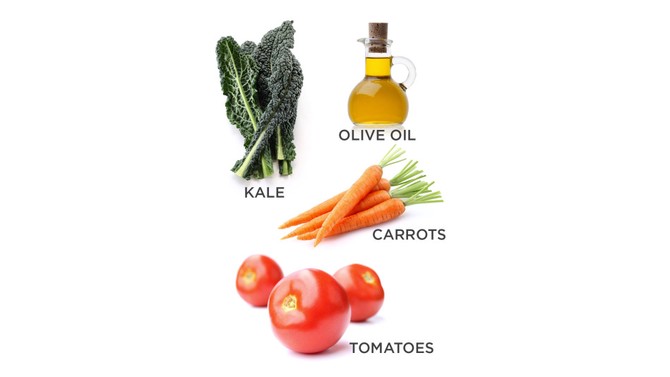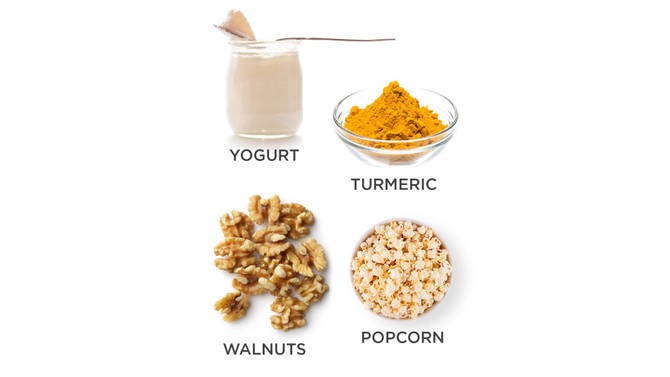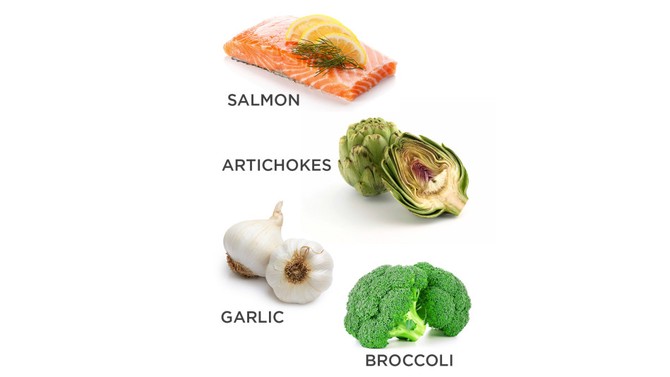3 Meals That Fight Inflammation (Plus 2 Snacks!)
Inflammation is linked to chronic illnesses ranging from heart disease to Alzheimer’s. Here’s what to eat to keep your health in check.
By Emma Haak

Photos: iStock
At Breakfast
The Menu: A mushroom and spinach omelet with a side of berries
The 30-Second Explanation: This meal has a lot of fiber, and a high fiber diet is linked to lower levels of inflammation.
And Everything Else You Might Want to Know: There’s a protein in your body (called C-reactive protein) that works like a marker of inflammation—when inflammation goes up, so do levels of the protein. More fiber is linked to less of the protein. Mushrooms have anti-inflammatory compounds too. Just don’t let them sauté for very long in the omelet pan—research suggests that they’re most beneficial when they’re raw. Berries, spinach, and even eggs, have antioxidants, known inflammation fighters.
Images clockwise from top left: istockphoto: Alina Solovyova-Vincent, mistertho, Creativeye99, Eivaisla

Photos: iStock
For Lunch
The Menu: Salad with a base of dark leafy greens plus other fruits and veggies like tomatoes and carrots, dressed with olive oil and lemon juice
The 30-Second Explanation: A colorful salad is a bonanza of antioxidants, which help stop inflammation before it starts.
And Everything Else You Might Want to Know: Your cells are prone to damage, especially from free radicals. When that happens, your body mounts an inflammatory response that’s meant to heal—but sometimes that response gets out of hand, and inflammation levels stay high (the same thing can happen in response to any kind of damage in the body). Antioxidants stop free radicals from harming cells, so inflammation levels don’t rise in the first place, says Lisa Cimperman, RD, spokesperson for the Academy of Nutrition and Dietetics and clinical dietician at University Hospitals Case Medical Center in Cleveland. The more colors, the better—even seemingly one-color leafy greens actually have a lot of different pigments in them, says Roxanne Sukol, MD, doctor of preventive medicine and medical director of the Wellness Enterprise at Cleveland Clinic. With olive oil in your dressing, you’ll get a dose of omega 3s and oleocanthal, a compound in the oil that works in a similar way as ibuprofen to lower inflammation (no word on whether you should down a shot of EVOO when headaches arise though). Throw some lemon juice in for added taste.
Images clockwise from top left: istockphoto: Toru Uchida, Savany, dionisvero, srdjan111

Photos: iStock
As a Snack
The Menu: Spiced-or-herbed up popcorn or yogurt with live, active cultures topped with walnuts
The 30-Second Explanation: Popcorn makes a great delivery vehicle for anti-inflammatory herbs and spices, while probiotics promote healthy gut bacteria linked to less inflammation.
And Everything Else You Might Want to Know: Popcorn is high in fiber, and sprinkling it with antioxidant-rich picks like turmeric, paprika, rosemary, or oregano works against inflammation on two levels. Turmeric might be particularly beneficial, and it’s often recommended for patients dealing autoimmune conditions like arthritis, says Sukol. The Arthritis Foundation recommends up to 3 grams per day, about the amount in 1 1/3 teaspoons.
(Sukol adds turmeric to her popcorn as a general inflammation fighter, and tells patients to do the same.) Your yogurt option is all about the microbiome. An imbalance between good and bad bacteria in your gut (in favor of the bad kind) can lead to inflammation, says Lisa Davis, PhD, co-author of Anti-Inflammatory Foods for Health. The cultures in the yogurt help build the healthy bacteria back up. Walnuts add a satisfying crunch, and their fatty acids help strengthen cell membranes to protect against damage, says Davis.
Images clockwise from top left: istockphoto: Delpixart, Kajdi Szabolcs, John_Kasawa, Floortje

Photos: iStock
At Dinner
The Menu: Salmon or mackerel with broccoli and artichokes (plus a generous amount of garlic)
The 30-Second Explanation: Cold-water fish are an excellent source of omega-3s, and artichokes are food for the good bacteria in your gut.
And Everything Else You Might Want To Know: Our diets are generally too high in pro-inflammatory omega 6’s and too low in anti-inflammatory omega 3’s, says Sukol. We need some inflammation in our bodies, so it’s not about cutting out omega 6’s completely—just eating more 3s than 6s. These two fish options will help you do that (other ideas: trout, herring, and sardines). You know about probiotics, but you may not have heard about prebiotics: foods that your gut doesn’t digest completely, leaving what’s left for the good bacteria in your digestive system to feast on. Artichokes, garlic (plus, leeks, onions, and asparagus) are all in that category. Finally, two compounds in broccoli help boost your cells natural defenses, says Jed Fahey, ScD, director of the Cullman Chemoprotection Center at Johns Hopkins and assistant professor in the department of international health, center for human nutrition, at Johns Hopkins Bloomberg School of Public Health. (Sulforaphanes, found in cruciferous veggies including broccoli, have been found to lower inflammation in mice too).
Images clockwise from top left: istockphoto: gbh007, Mostafa Hefni, tanuha2001, macida
Published 04/19/2016

